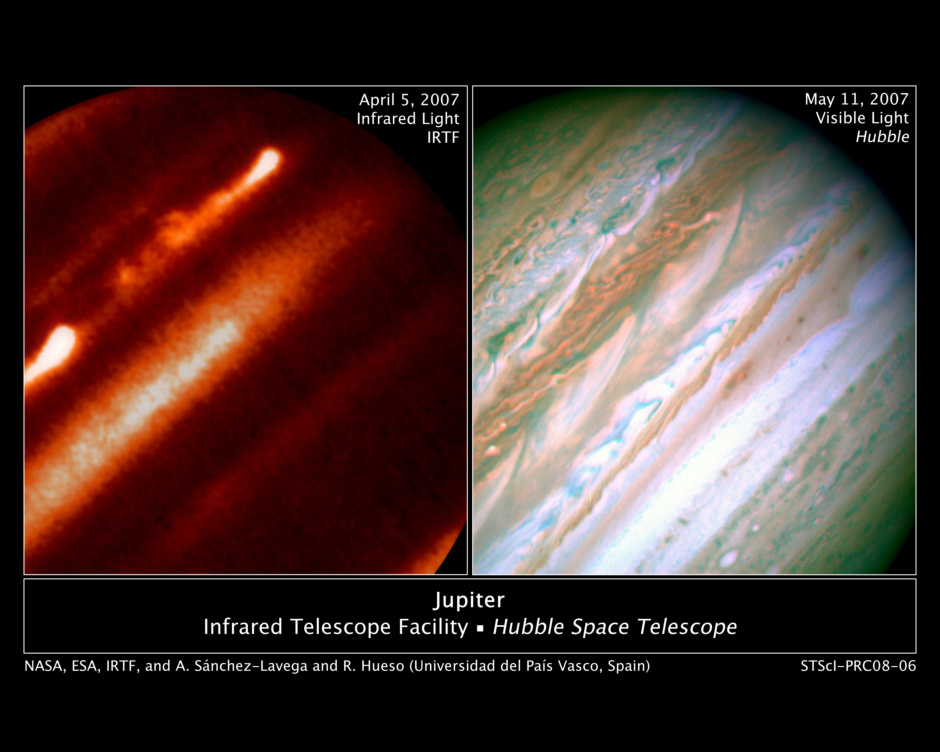사진설명>왼쪽 이미지는 2007년 4월 5일 촬영된 적외선 이미지로, 하와이의 적외선 망원경(Infrared Telescope Facility (IRTF))으로 촬영되었다.
오른쪽 가시광선 이미지는 허블우주망원경으로 2007년 5월 11일 촬영한 것으로 상단 좌측에 두 개의 분출구름에 의해서 생성된 대기 폭풍의 패턴을 보여주고 있다.
2007년 3월에 목성 대기상에 분출된 2개의 폭풍에 대한 세부 분석을 통해 목성 내부의 열기가 목성 대기상에 동요를 발생시키는 주요한 역할을 수행한다는 사실을 알게 되었다.
천문학자들은 이러한 폭발양상의 이해를 통해 목성 대기 깊숙한 곳에서 발생하는 신비로운 대류의 비밀을 밝힐 수 있다고 말한다.
이러한 현상들에 대한 이해를 통해 대기의 순환에서 주요한 역할을 수행하는 제트기류와 지구 곳곳에서 발생하는 폭풍과 같은 지구의 기상학적 현상에 대한 이해도 가능하다.
즉, 목성은 기상학자들이 강력한 제트기류와 격렬한 대기현상간의 상호작용을 연구하는데 있어 중요한 자연 도서관의 역할을 수행하는 것이다.
스페인 바스코대학의 어구스틴 산체스-라베가(Agustin Sanchez-Lavega)가 지도하는 국제협력연구팀은 이번 발견을 1월 24일 네이처 지에 발표하였다.
연구팀은 목성 대기의 구름분출활동과 진화과정을 허블망원경과 하와이의 적외선 망원경, 스페인 카나리 섬의 천문관측을 통해 전례가 없는 고분해능으로 관측할 수 있었다.
또한 이번 관측에는 전세계 곳곳의 소규모 천문관측 네트워크의 지원도 있었다.
분석자료에 의하면 밝게 나타나고 있는 분출물들은,목성 깊숙한 곳의 수증기 구름들이 대기 상층으로 올라오면서 발생한 일련의 폭풍과 이 구름들 위로 고체 및 액체 암모니아의 혼합물들이 30킬로미터 높이로 분출되면서 나타나는 것으로 알려졌다.
이 폭풍들은 목성 대기의 제트기류의 영향으로 최대 시속 600킬로미터의 속도로 움직이고 있다.
이번 폭풍 모델은 목성의 제트기류가 목성 대기 깊숙이까지 확장되고 있음을 알려주고 있는데, 구체적으로 태양빛을 흡수하여 밝게 빛나고 있는 구름 상층부의 하단으로 거의 100킬로미터 이상까지 파고들어가고 있음을 알려주었다.
* '허블사이트'의 게시물들은 허블사이트 http://hubblesite.org 의 뉴스센터 자료들을 번역한 자료들입니다.
본 내용은 2008년 1월 23일 발표된 뉴스입니다.
참고 : 목성대기의 다양한 풍경 등, 목성과 목성의 달에 대한 각종 포스팅은 아래 링크를 통해 조회할 수 있습니다.
https://big-crunch.tistory.com/12346946
원문>
Detailed analysis of two continent-sized storms that erupted in Jupiter's atmosphere in March 2007 shows that Jupiter's internal heat plays a significant role in generating atmospheric disturbances. Understanding this outbreak could be the key to unlock the mysteries buried in the deep Jovian atmosphere, say astronomers.
Understanding these phenomena is important for Earth's meteorology where storms are present everywhere and jet streams dominate the atmospheric circulation. Jupiter is a natural laboratory where atmospheric scientists study the nature and interplay of the intense jets and severe atmospheric phenomena.
An international team coordinated by Agustin Sánchez-Lavega from the Universidad del País Vasco in Spain presents its findings about this event in the January 24 issue of the journal Nature.
The team monitored the new eruption of cloud activity and its evolution with an unprecedented resolution using NASA's Hubble Space Telescope, the NASA Infrared Telescope Facility in Hawaii, and telescopes in the Canary Islands (Spain). A network of smaller telescopes around the world also supported these observations.
According to the analysis, the bright plumes were storm systems triggered in Jupiter's deep water clouds that moved upward in the atmosphere vigorously and injected a fresh mixture of ammonia ice and water about 20 miles (30 kilometers) above the visible clouds. The storms moved in the peak of a jet stream in Jupiter's atmosphere at 375 miles per hour (600 kilometers per hour). Models of the disturbance indicate that the jet stream extends deep in the buried atmosphere of Jupiter, more than 60 miles (approximately100 kilometers) below the cloud tops where most sunlight is absorbed.
For additional information, contact:
Ray Villard
Space Telescope Science Institute, Baltimore, Md.
410-338-4514
villard@stsci.edu
Carolina Carnalla-Martinez
Jet Propulsion Laboratory, Pasadena, Calif
818-354-9382
carnalla@jpl.nasa.gov
Agustin Sánchez-Lavega
Universidad del País Vasco, Spain
011-34-94-601-4255
agustin.sanchez@ehu.es
Object Name: Jupiter
Image Type: Astronomical/Illustration
Credit: NASA, ESA, IRTF, and A. Sánchez-Lavega and R. Hueso (Universidad del País Vasco, Spain )
'3. 천문뉴스 > 허블사이트' 카테고리의 다른 글
| NGC 1132 (0) | 2008.02.07 |
|---|---|
| NGC 602, N90 (0) | 2008.01.28 |
| HD 61005를 둘러싼 먼지원반 (0) | 2008.01.15 |
| Abell 901, 902 은하단의 암흑물질 분포 (0) | 2008.01.13 |
| 이중 중력 렌즈 고리(SDSSJ0946+1006) (0) | 2008.01.12 |
